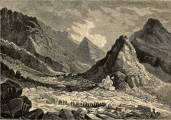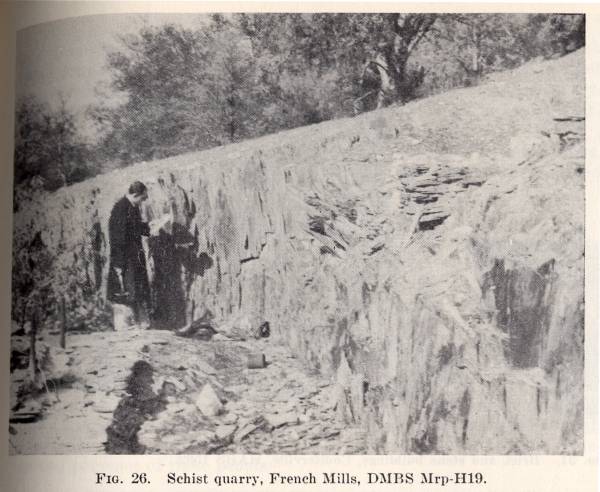



Building Materials of the California Gold Country
A Selective Photographic Tour from Mariposa in Mariposa
County
to Auburn in Placer County
Geologic Guidebook Along Highway 49
Sierran Gold Belt: The Mother Lode Country, Bulletin 141, 1948
Introduction and History
(Click Here to go to Towns and Sites Visited or Attempted)
When men flooded into California in their search for gold in 1849, they were not concerned at first with the types of dwellings they lived in. The arrival of women and families needing more secure homes and due to the many fires that burned the Gold Country towns time and time again, solid, fire-resistant buildings were needed. For this purpose, many local materials were used including wood, adobe, brick and stone.
Very little stone was used in construction in California prior to 1850; the first granite quarries opened in California in 1853. For many years most of the marble and granite used was imported from New England, Indiana, Georgia, or Europe. The first stone building constructed in San Francisco was the the three-story Parrott Block constructed of dressed granite blocks 'pre-fabricated' – cut and fitted in China, marked with Chinese characters, and shipped to California to be erected by Chinese labor in 1852. During the Gold Rush period, the building materials desired were materials that could be used for quick construction. Many men came to California during that period from the eastern part of America and foreign countries and they brought their knowledge and skills with them from the stone industries in eastern American and Europe. Their knowledge and skill were of great value in building California's permanent structures. There are many buildings and some quarries left today that show the effort of such men.
In order to find various representative occurrences of different types of building materials used, my husband Pat and I took a trip to visit some of the towns and quarries in the Gold Rush country seeking out the origin of the building stone and the buildings that were created.
California's marble and granite industries were very young relative to foreign countries. Italy and other countries had been using stone for building purposes for many centuries. A couple of examples are the Roman Coliseum, which was built in 80 A.D., and the Taj Mahal in India, which was completed in 1648.
In The Marble-Workers' Manual of 1856, the author listed many states in America that contained and/or quarried marble. The author considered Vermont to be "the Marble state." Of California he wrote: "Marble has been found in Marin County, and in some other parts of California." He also noted that the 1850 California Census only listed two stone cutters. He went on to state that the quality of the marble of America was unknown to the people in Europe. No marble specimens were sent to the Great London Exhibition, although Vermont marble was displayed at the New York Crystal Palace Exhibition in 1853.
Even though there were many sources in America for stone, it was imported from foreign countries mainly for three reasons. Stone had been quarried in foreign countries for centuries (such as marble in Italy), and the foreign stone had an established reputation and there were established trade routes in place. Secondly, those who could afford grand buildings and monuments had a prejudice towards foreign marble and granite, and so the building industry catered to these customers. The third, and most important reason, is one that still applies todaystone quarried abroad was cheaper due to a lower wage paid to the quarriers and stone cutters in 1856 than in America. The author of The Marble-Cutters Manual states: ".when the Italian statuary marble was selling in New York at $2.50 to $3.00 per cubic foot, that from Rutland, Vt., cost $4.50."
For Californians, local sources of stone were desired. Due to this many people in the state began to encourage the exploration and use of materials from California rather than import materials into the state. The first developed stone resource in California is reported to have been at Folsom, Placer County, in the Sierra Nevada foothills, which began quarrying granite in 1856. Granite quarries were developed at nearby Rocklin (opened in 1863) and Penryn (opened in 1864) both in Placer County. Large marble quarries were established in Tuolumne County at Columbia probably in the very early 1850s, although on January 10, 1857, an article in The Weekly Columbian was published about the stone yard of Roberts and Vincent. For information about the stone quarries located in the southern Gold Rush Area of California, visit the California quarry sections of our web site (divided by county).
As stated previously, we used the book Geologic Guidebook Along Highway 49 - The Mother Lode, published in 1948. This was a wonderful guidebook with many photographs from about 1946 when it was prepared. (I have placed many of the relevant photographs from the 1948 publication on this page with permission obtained from the California Department of Conservation, Department of Mines and Geology.) We found that road names have changed as have the buildings and quarries described. Many times it was like a treasure hunt trying to match the site locations and names with today's terrain. Like that book, we started our trip at the southern extent of the Gold Rush country at Mormon Bar just south of Mariposa, Mariposa County, where the Mother Lode gold-bearing quartz veins terminate. Due to time constraints I only chose about 25 sites to visit. The northernmost town that we were able to see was Auburn in Placer County. Our trip followed Highway 49 and included several side trips. In the future we plan to complete our tour along the northern portion of Highway 49. Those results will also be published on this web site.

|
|
Used with permission of the California Department of Conservation, Division of Mines and Geology from Bulletin 141 (Geologic Guidebook Along Highway 49, Bulletin 141) |
The building materials in the Gold Rush country include: bricks of molded clay set in lime mortar, adobe, limestone (used as building blocks, lime stucco, and lime mortar), marble, sandstone, rhyolite tuff (used as early as 1851 and locally known as "lava"), serpentine, meta-andesite agglomerates (also known as green stones), slate, gabbro, schists, talc schist or soapstone, brick, cherts, and granite. There are many examples in the Gold Rush Country towns and surrounding areas of structures built of these materials. We were unable to locate the quarries or specific outcrops mentioned in our guide book. Most of the Gold Country today seems to be posted with no trespassing signs or the terrain has changed in the extreme and we were limited to three days to search.

|
|
Used with permission of the California Department of Conservation, Division of Mines and Geology from Bulletin 141 (Geologic Guidebook Along Highway 49, Bulletin 141) |
Besides what was available locally for building purposes, the building styles were influenced by the cultural background of the residents. Mexican minersfrom Mexico were accustomed to adobe bricks. The Americans from the East favored brick. Even though some of the buildings were built of other stone, many times Americans covered the stone or made the front facade out of brick. People from the Midwestern part of the country were used to building dry rock walls from stones cleared from the fields and they were familiar with building frame structures on stone foundations. In the Geologic Guidebook Along Highway 49 - The Mother Lode (1948), the author wrote: "The stone masons par excellence were the Italians who came to the gold fields. In the central and southern section of the Mother Lode region a large proportion of the good stone buildings, especially those of rhyolite tuff, bear Italian names." Many of the Gold Rush Country stone buildings have stood so long because the area lies outside of the earthquake region.
Towns and Sites Visited or Attempted:

- Mariposa and Mormon Bar
- Bear Valley
- Schist and Serpentine Outcroppings between Bear Valley and Coulterville
- Coulterville
- Chinese Camp
- Columbia Marble Quaries
- Vallecito
- Murphys
- Volcano
- Fiddletown
- Oleta Marble Quarry, Amador County **
- Plymouth
- Mokolumne Hill & Rhyolite Tuff Outcropping
- Mokolumne Hill-Rhyolite Tuft Quarry **
- San Andreas
- Treat Marble Quarry (1¼ east of San Andreas)**
- Jenny Lind
- Altaville &Altaville Rhyolite Tuff Quarry (east of Altaville and Angels Camp)
- Tombstone Rocks South of Sutter Creek
- El Dorado
- Limestone Quarry North of Cool
- Auburn
** Attempted but not located
Sources For The Gold Rush Country, California Building
Materials Report
Below are the sources I used as references for this report. Some of these sources will only be listed here and will not be included in the sources list for this online web site.
Books
-
Alt, David D. and Donald W. Hyndman. Roadside Geology of Northern California. Mountain Press Publishing Co., Missoula, Montana, 1975.
-
Aubury, Lewis E., State Mineralogist (under the direction of). The Structural and Industrial Materials of California: Bulletin NO. 38. California State Mining Bureau. Superintendent State Printing, Sacramento, 1906.
-
Automobile Club of Southern California. The Mother Lode. Automobile Club of Southern California, Travel Publications Department, Los Angeles, California, 1988.
-
Birkeland, Peter W. and Edwin E. Larson. Putnam's Geology. Oxford University Press, New York, 1989.
-
Booth, M. L. (Translated from the French). The Marble-Workers' Manual: Designed for the Use of Marble-Workers, Builders, and Owners of Houses (with an Appendix Concerning American Marbles. Sheldon, Blakeman & Co., New York, 1856.
-
De Ferrari, Carlo M. Historical Background Report on the Limestone Quarries Operated by Blue Mountain Minerals, Tuolumne County. August 1997.
-
Hamblin, W. Kenneth and J. Keith Rigby. Roadside Geology of U.S. Interstate 80 between Salt Lake City and San Francisco: The Meaning Behind the Landscape. Varna Enterprises, Van Nuys, California, 1975.
-
Hill, Mary. Geology of the Sierra Nevada. California Natural History Guides: 37. University of California Press, Berkeley, Los Angeles, London, 1975.
-
Holbrook, Stewart H. The Yankee Exodus: An Account of Migration from New England. The MacMillan Company, New York, 1950.
-
Jenkins, Olaf P. (prepared under the direction of). Geologic Guidebook Along Highway 49Sierran Gold Belt: The Mother Lode Country, Bulletin 141. State of California, Department of Natural Resources, Division of Mines, San Francisco, California, September 1948.
-
Jenkins, Olaf P. (prepared under the direction of). Geologic Guidebook of the San Francisco Bay Counties, Bulletin 154. State of California, Department of Natural Resources, Division of Mines, San Francisco, California, September December 1951.
-
McGarvey, G. A. and H. H. Sherman. Granite Cutting: An Analysis of the Granite Cutter's Trade Together with Specimen Instruction Material for Use in Apprentices and Journeymen Workers. Vocational Division Bulletin No. 137; Trade and Industrial Series No. 38. United States Department of the Interior, United States Government Printing Office, Washington, reprinted 1938.
-
Stillwell, Lewis D. Migration From Vermont. Vermont Historical Society, Montpelier, 1948.
Electronic Sources
-
Grolier's Multimedia Encyclopedia. Grolier Electronic Publishing, Inc., 1993.
-
Polvaccio Quarries, The.
-
Roman Art and Architecture, Visual Arts History and Humanities Images, University of Colorado, Colorado Springs, Colorado, April 3, 1999.
Commercial use of material within this site is strictly prohibited. It is not to be captured, reworked, and placed inside another web site ©. All rights reserved. Peggy B. and George (Pat) Perazzo.